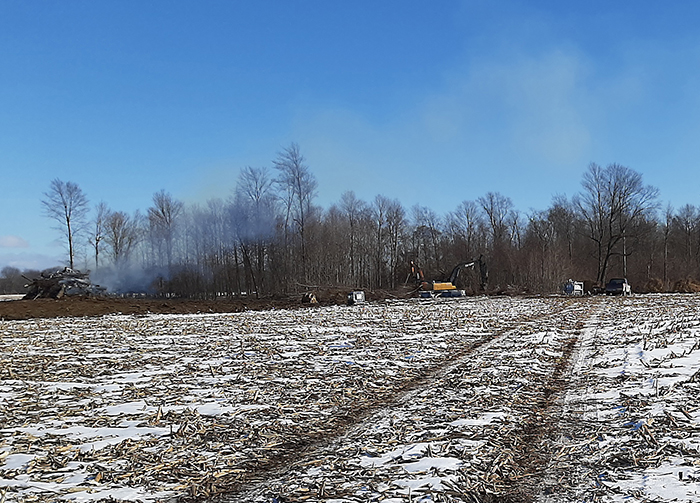
By Jenna Cocullo, Local Journalism Initiative
Ontario’s Ministry of the Environment (MoE) involved itself in the Spence Line tree-cutting dispute after receiving a number of complaints regarding the clearing of trees on the privately owned property.
The site is alleged to be habitat for multiple plant and animal species at risk.
The private property owners are within their rights to cut down the trees, and no permit was needed from the Municipality of Chatham-Kent for the work.
The Chatham Voice reached out to the homeowners via telephone and they declined to comment on the situation.
The Voice is not publishing the names of the homeowners who said they have been subject to a lot of harassment.
The ministry’s Environmental Investigations and Enforcement Branch visited the site and issued a verbal stop order under the Endangered Species Act, 2007 on Jan. 29, confirmed Gary Wheeler, spokesperson for the ministry.
Ken Bell, a member of the Great Lakes Community Eco Initiative, said this woodland is particularly important because it has been identified as a habitat for American Chestnut, which according to the Ministry of Natural Resources and Forestry is endangered.
In Ontario, American Chestnut is only found in the Carolinian Zone between Lake Erie and Lake Huron. Maps from the ministry show that there is a concentration of the tree in East Kent. Bell said there is no way of knowing if American Chestnuts are on that particular grid.
CK Woodlot, a local tree conservationist group, brought the issue to the public’s attention.
“We made a call to action on our Facebook page giving out the Ministry of Environment phone number and encouraging people to call that tip line just to have them out there to investigate,” said Andrea O’Rourke, one of its founding members. “From what I understand after that posting a lot of people from the public did make those phone calls.”
READ MORE: Deforestation concerns grow
From a municipal standpoint, no laws were broken as Chatham-Kent is one of two jurisdictions in Ontario which do not have a forest bylaw enforcement officer. If there are endangered species on the woodlot, the homeowners would have violated the provincial Endangered Species Act. A written stop order was issued to the property owner on Feb. 4 under section 27(1) of the Act.
The order requires that the owner stop all activities prohibited by the Act and not to engage in any prohibited activities, such as killing, harming or harassing species at risk and damage or destruction of habitat.
The property owner was provided with the appropriate ministry contacts to determine options and next steps to maintain compliance with the Endangered Species Act (ESA) with regard to the woodlot.
Wheeler said the ministry will revoke the stop order if compliance is achieved, which could include confirmation of no impact to habitat or species at risk, permanent work stoppage or issue of an authorization to continue work.
“Should the ministry establish violations, including if the stop order is violated, the site owner may be subject to prosecution. Should charges be brought before the court, the outcome is ultimately at the discretion of the court,” explained Wheeler.
If a person is convicted of an offence under the Act and it is their first offence, they can be fined up to $250,000 and/or imprisoned up to a year.
“We’re glad that they responded for sure,” O’Rouke said.
“But we can’t claim it as a success other than getting attention on the issue. If they don’t find a species at risk though within that bush, and it’s very hard in the winter to assess that, they could continue clearing for all we know. And at this point in Chatham-Kent, the only power we have to stop any potential clearing is species at risk because obviously we have no bylaw.”
Bell recently launched an online petition requesting that council and administration rezone all significant woodlands more than two hectares in size to an Open Space, from Agricultural Use, designation for the purpose of conservation.
In 2014, Chatham-Kent council decided not to implement a tree-cutting bylaw but rather chose to adopt a National Heritage Strategy to encourage education and tree planting initiatives.
READ MORE: Resident wants protection for C-K woodlots
Wheeler said if other homeowners are looking to cut down woodlots, they should first look at the Endangered Species Act which provides tools to support protection of identified species at risk and their habitat and could prevent them from breaking any laws.
Proponents seeking to obtain permits and agreements can contact the ministry through [email protected].
“As a first principle, the ministry looks to clients to plan projects and activities to avoid impacting species at risk and their habitat. Where it has been identified that impacts cannot be avoided, the ESA contains authorization tools such as permits that enable activities to proceed,” he said.






